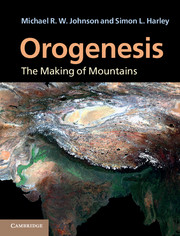Book contents
- Frontmatter
- Contents
- Preface
- Acknowledgments
- Geological timescale
- 1 Major features of the Earth and plate tectonics
- 2 Driving mechanisms for plates, slab retreat and advance, and a cause of orogenesis
- 3 Physical and chemical principles: rock deformation, isostasy, geochronology and heat production in the lithosphere
- 4 Large-scale features of orogens: thrusts and folds
- 5 Evolution of orogens
- 6 Lateral spreading of orogens: foreland propagation, channel flow and weak zones in the crust
- 7 Metamorphism in orogeny
- 8 The erosion and exhumation of mountains
- 9 Sedimentary history of the foredeep basins
- 10 Deep structure, mountain support and phase changes
- 11 Mountains and climate
- 12 Secular change in orogeny
- References
- Index
- Plate section
9 - Sedimentary history of the foredeep basins
Published online by Cambridge University Press: 05 June 2012
- Frontmatter
- Contents
- Preface
- Acknowledgments
- Geological timescale
- 1 Major features of the Earth and plate tectonics
- 2 Driving mechanisms for plates, slab retreat and advance, and a cause of orogenesis
- 3 Physical and chemical principles: rock deformation, isostasy, geochronology and heat production in the lithosphere
- 4 Large-scale features of orogens: thrusts and folds
- 5 Evolution of orogens
- 6 Lateral spreading of orogens: foreland propagation, channel flow and weak zones in the crust
- 7 Metamorphism in orogeny
- 8 The erosion and exhumation of mountains
- 9 Sedimentary history of the foredeep basins
- 10 Deep structure, mountain support and phase changes
- 11 Mountains and climate
- 12 Secular change in orogeny
- References
- Index
- Plate section
Summary
A familiar feature of orogens is the presence of a sedimentary basin, termed a foredeep basin, situated ahead of the orogen. The foredeep basins are filled in the main by the erosional detritus from the adjacent orogen, and good examples are the Siwalik basin of the Himalaya and the molasse basins of the Alps and Andes. The driving force for the erosion is mountain uplift. Before considering examples of foredeep basins we must first look at the controls on basin formation.
Isostasy and Bouguer anomalies
A full understanding of the physical relations between a mountain chain and the adjacent foreland basins calls for some knowledge of the gravitational factors involved in mountain building. The famous experiments in the Peruvian Andes by Bouguer in 1735 and 1745 established that there is a mass deficiency in mountain belts. Bouguer demonstrated this by measuring the deflection of a plumb line towards the Andes and showing that it was much less than expected from the huge bulk of the mountains. The gravity anomalies thus demonstrated are now named after him. Thus under mountains there is a negative Bouguer anomaly (Figs. 9.1, 9.2).
- Type
- Chapter
- Information
- OrogenesisThe Making of Mountains, pp. 274 - 287Publisher: Cambridge University PressPrint publication year: 2012



